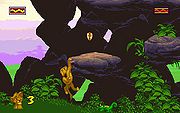Difference between revisions of "The Lion King (game)"
| Line 18: | Line 18: | ||
The Windows 3.1 version relied on the WinG graphics engine, but a series of Compaq Presarios weren't tested with WinG, which caused the game to crash while loading. This led Microsoft to create the more stable engine DirectX, used to this day. | The Windows 3.1 version relied on the WinG graphics engine, but a series of Compaq Presarios weren't tested with WinG, which caused the game to crash while loading. This led Microsoft to create the more stable engine DirectX, used to this day. | ||
| + | |||
| + | |||
| + | == External links == | ||
| + | * [http://games.softpedia.com/get/Freeware-Games/Lion-King.shtml Download Lion King 1.0] from Softpedia (Windows) | ||
[[Category:Media]] | [[Category:Media]] | ||
[[Category:Video games]] | [[Category:Video games]] | ||
Revision as of 21:45, 31 March 2011
The Lion King is a video game based on the movie. The title was published by Virgin Interactive in 1994, and was released on SNES, NES, Game Boy, PC, Sega Mega Drive/Genesis, Amiga, Master System and Game Gear. (The NES and Master System versions of the game were never released in North America.) It followed Simba's journey from a young carefree cub to the battle with his Uncle Scar as an adult.
Gameplay
The game is a side-scrolling platform game, with the controlled character having to leap, climb, run and descend from platform to platform. There is an exception during the level The Stampede, where Simba is running towards (or in the NES and Game Boy versions, running with the camera looking straight down on top of him) the camera dodging wildebeest and leaping over rocks.
In most versions of the game two bars appear on the HUD. To the left is the roar meter, which must be fully charged for Simba's roar to be effective. To the right is the health bar which decreases when Simba is hurt. At the bottom left of the screen is a counter showing how many lives Simba has remaining. Health can be restored by collecting bugs which come in a variety of shapes and sizes. Some rare health-damaging bugs also exist.
The player controls Simba (first as a cub, then later as an adult) in the main levels and either Timon or Pumbaa in the bonus levels.
Console Differences
The sound and graphic quality of the game varied greatly due to the differing capabilities of the consoles. On the MS-DOS version, sound quality varied greatly depending on the sound hardware present on the PC and how the game is configured, as the MS-DOS version requires the installed sound card to be selected from a list using a separate utility that ships with the game, and required technical knowledge of the card's IRQ and DMA settings. The game supported most of the most popular soundcards available in the market at the time of its release, including Ad-Lib music, Disney Sound Source, the Gravis Ultrasound and SoundBlaster 16. However it would still fail to work correctly on certain Soundblaster clones, especially if the clone uses non-standard IRQ or DMA settings. The SNES and Genesis versions are similar, with the Genesis having more grainy sprites and background, and the SNES being a little slower than the Genesis one.
The Amiga version omitted the Can't Wait to be King level, the bonus levels and the cutscenes, presumably to save disk space as the media was presented on floppy disks. The music for some levels was also remixed slightly differently. However, the MS-DOS version was also shipped on 3 floppy disks, but included the missing levels, and has the exact same music as the Super Nintendo version on supported hardware.
The NES version omitted content even further, with only the cub Simba levels present and the removal of the short Death Tag piece of music that plays when Simba dies. The level music continues on instead. Levels were also shortened considerably.
The Windows 3.1 version relied on the WinG graphics engine, but a series of Compaq Presarios weren't tested with WinG, which caused the game to crash while loading. This led Microsoft to create the more stable engine DirectX, used to this day.
External links
- Download Lion King 1.0 from Softpedia (Windows)

